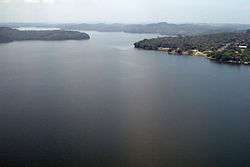Billings Reservoir
| Billings Reservoir | |
|---|---|
 | |
| Location | Santo André, São Bernardo do Campo, Diadema, Ribeirão Pires, Rio Grande da Serra, São Paulo |
| Coordinates | 23°47′13″S 46°35′02″W / 23.787°S 46.584°WCoordinates: 23°47′13″S 46°35′02″W / 23.787°S 46.584°W |
| Type | reservoir |
| Basin countries | Brazil |
| Surface area | 127 km2 (49 sq mi) |
The Billings Reservoir (locally known as Represa Billings) is the largest reservoir in São Paulo, Brazil, covering a total of 127 km2. It is named after Asa White Kenney Billings, the American hydroelectric engineer who was instrumental in building it. The Portuguese word represa also means "dam".
The reservoir supplies about 1.8 million people, and also is used for fishing and swimming. In recent years, there have been problems with wastewater and garbage such as plastic bottles, as well as problems associated with unapproved human settlement in the surrounding regions.[1]
History
The hydroelectric projects were built starting in 1927, and the first phase was completed between 1935 and 1937. The project was started by the São Paulo Tramway, Light and Power Company, Limited (a company headquartered in Canada, with British and other foreign capital), today Eletropaulo. Water is drawn from the basin of the high Tietê River to Henry Borden hydroelectric power plant, in Cubatão. In 1956 an underground plant was added. Increasing the power output to 880 Megawatts.
See also
References
- ↑ Balazina, Afra (April 4, 2010). "Billings chega aos 85 anos com saúde fragilizada". Estadão.com.br (in Portuguese). O Estado de S. Paulo. Retrieved 28 December 2014.
External links
- "Water Resources of Sao Paulo, Brazil". ghaly.union.edu. Retrieved 2014-05-31.
- https://web.archive.org/web/20090522042852/http://www.mananciais.org.br:80/site/mananciais_rmsp/billings/ahistbill